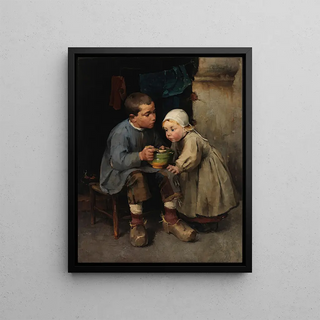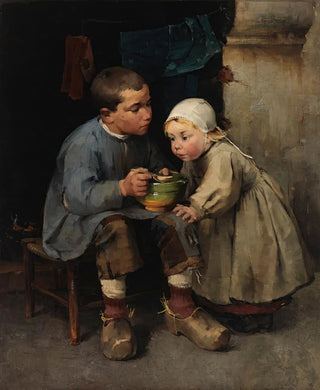Art print | A boy feeds his little sister - Helene Schjerfbeck


View from behind

Frame (optional)
The artwork "Un garçon nourrit sa petite sœur" by Helene Schjerfbeck is an iconic piece that evokes tenderness and the simplicity of family relationships. This canvas, created in the early 20th century, immerses us in a universe where children's everyday life is elevated by the artist's sensitivity. Through this painting, Schjerfbeck manages to capture a fleeting moment, a gentle interaction between two young protagonists. The viewer's gaze is immediately drawn to the scene, an image that resonates with childhood innocence and the warmth of fraternal bonds. This work does not merely depict an action; it tells a story, that of pure fraternal love, which transcends time and space.
Style and uniqueness of the work
Schjerfbeck stands out with her unique style, blending a realistic approach with an impressionist sensibility. In "Un garçon nourrit sa petite sœur," the forms are simplified, the colors soft, and the contours slightly blurred, creating an almost dreamlike atmosphere. The artist uses light with remarkable mastery, illuminating the children's faces with a warm glow that emphasizes their expression. The delicate gestures of the boy, who offers a piece of bread to his sister, are rendered with such finesse that one can almost feel the tenderness of this gesture. The composition, centered on the two children, eliminates any distraction, allowing the viewer to fully absorb the emotion emanating from this scene. This painting is a perfect example of Schjerfbeck's ability to transform ordinary moments into poignant moments of beauty.
The artist and her influence
Helene Schjerfbeck, a prominent figure in Finnish art, has established herself through her innovative approach and unique artistic vision. Born in 1862, she experienced the artistic currents of her time, from realism to modernism, while developing a personal style that is her own. Her work is often marked by deep introspection and an exploration of themes such as solitude, memory, and identity. Schjerfbeck was also influenced by impressionist artists

Matte finish

View from behind

Frame (optional)
The artwork "Un garçon nourrit sa petite sœur" by Helene Schjerfbeck is an iconic piece that evokes tenderness and the simplicity of family relationships. This canvas, created in the early 20th century, immerses us in a universe where children's everyday life is elevated by the artist's sensitivity. Through this painting, Schjerfbeck manages to capture a fleeting moment, a gentle interaction between two young protagonists. The viewer's gaze is immediately drawn to the scene, an image that resonates with childhood innocence and the warmth of fraternal bonds. This work does not merely depict an action; it tells a story, that of pure fraternal love, which transcends time and space.
Style and uniqueness of the work
Schjerfbeck stands out with her unique style, blending a realistic approach with an impressionist sensibility. In "Un garçon nourrit sa petite sœur," the forms are simplified, the colors soft, and the contours slightly blurred, creating an almost dreamlike atmosphere. The artist uses light with remarkable mastery, illuminating the children's faces with a warm glow that emphasizes their expression. The delicate gestures of the boy, who offers a piece of bread to his sister, are rendered with such finesse that one can almost feel the tenderness of this gesture. The composition, centered on the two children, eliminates any distraction, allowing the viewer to fully absorb the emotion emanating from this scene. This painting is a perfect example of Schjerfbeck's ability to transform ordinary moments into poignant moments of beauty.
The artist and her influence
Helene Schjerfbeck, a prominent figure in Finnish art, has established herself through her innovative approach and unique artistic vision. Born in 1862, she experienced the artistic currents of her time, from realism to modernism, while developing a personal style that is her own. Her work is often marked by deep introspection and an exploration of themes such as solitude, memory, and identity. Schjerfbeck was also influenced by impressionist artists






